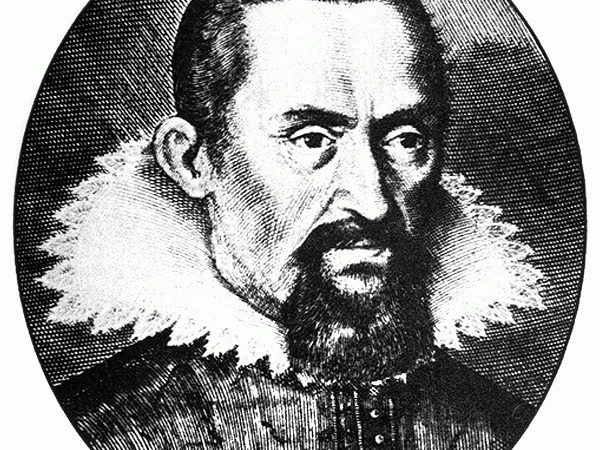Kepler’s role in the Scientific Revolution is often regarded as mystic and theological. But his support of Copernicus’ ideas and his commitment to empirical observations made him one of the most important astronomers of his generation.
Early years
Born in Germany in 1571, Johannes Kepler was a weak and sick child, but quickly revealed an extraordinary aptitude for mathematics. His modest family could not support the financial burden of Kepler’s education, but he benefited from a scholarship that allowed him to study at the Tubingen University.
During the 16th century, education was mainly under the control of religious institutions, either Roman Catholic or Protestant. The Tubingen University was no exception, being under the influence of the Lutherans. For Kepler, who wanted to become a theologian, religion indeed played a pivotal role in his theories about the Cosmos.
Religion
Kepler often said that Divine Providence guided him to study the stars and that was what he did for most of his life. God and Nature were two indivisible parts of the Universe and Kepler believed that the divine plan was written in Nature. The influence of Lutheranism was clear in his search for human knowledge, as he believed that natural philosophy was a gift from God so that Humans could reach Him.
During his studies in the university, Kepler’s professor Maestlin introduced him to Copernicus’ revolutionary ideas. Breaking the established astronomic view of the world, Copernicus stated that the Sun, and not planet Earth, was at the center of the Universe.
The heliocentric view fascinated young Kepler, who went to pursue his interest in astronomy. But, if Copernicus’ theory captivated Kepler, that cannot be said for most people. The heliocentric view clashed against the catholic notion of the Universe. In addition, Copernicus’ work lacked some accuracy, which made his theories hardly more acceptable than the previous Ptolemaic ones.
First theories
In 1596, Kepler wrote his first book, in support of Copernicus. In the Mysterium Cosmographic, Kepler claims to unveil the sacred plan of God for the Cosmos. Since God is a restless and creative being, His presence was reflected in the Sun’s continuous movement.
Thus, instead of Copernicus’ passive Sun, Kepler proposed a different view, in which a single force from the Sun accounts for the increasingly long periods of motion as the planetary distances increase.
The court astronomer
After leaving the Tubingen University, Kepler was invited to be a professor of mathematics and astronomy in a small Lutheran school, in Graz, Austria. There, he started to correspond with one of the best astronomers of his time, Tycho Brahe. This Danish astronomer followed the tremendously meticulous task of measuring planetary positions and he did so in an extremely accurate manner, considering that instruments such as the telescope had not yet been invented.
With the Protestant Reform and a subsequent period of religious and political unrest, Kepler lost his job in Graz. He decided to leave Austria and work personally with Brahe in Prague. But Brahe, who was working for the Emperor Rudolph II, died suddenly in 1601, soon after Kepler arrived. For Kepler, this was an opportunity to pursue Brahe’s astronomic observations and he started working as the official court astronomer.
Kepler’s laws of planetary motion
Without Brahe’s astronomic observations, Kepler wouldn’t have been able to draw his first law: “The orbit of a planet is an ellipse, with the Sun at one focus. The moon, in the same way, travels in an ellipse around the earth.” Formulated in 1609, it was originally intended to explain Mars’ trajectory, but it was later applied to all planets.
In the same year, Kepler also described his second law of planetary motion: “The velocity of a planet varies with its distance from the sun in such a way that a line joining the planet with the sun sweeps out equal areas in equal times”.
The third law (“The square of the period of any planet is proportional to the cube of the semimajor axis of its orbit.”) would only be set a decade later. It explained the relationship between the distances of the planets from the Sun and their orbital periods. Simply put, the law shows that the farther a planet is from the Sun, the slower it moves. A derivation of Kepler’s third law was made by Newton, who reformulated it in the light of his own gravitational force law.
A disruptive astronomer
Kepler’s laws of planetary motion represented a disruption with most of what was believed about the astronomic world until then. They show how Kepler broke the theoretical principles of Ptolemaic astrology, with an empirical precision that was rare at that time.
When the Emperor Rudolph II abdicated the throne in 1611, Kepler continued his job as the official court astronomer under the orders of the new emperor. He hoped to find an academic position in the Tubingen University, but his theological views and connections with Catholics and Calvinists were seen by the University administration as an impediment for the job.
Kepler eventually found a job as a mathematician in Linz, where he stayed until 1626. Meanwhile, his personal life was going through a troublesome period, with the death of his wife and one of his sons and the exclusion from the Lutheran community. After he remarried, five of his seven children died in childhood.
The last years
In Linz, he continued to work on Brahe’s findings, but he put much of his time on a passion he had since his youth: the study of harmonies. In the book Harmonice Mundi, Kepler explains that all harmonies are geometrical and the planets’ motions fell into harmonies of the celestial system. Besides studying harmonies, Kepler was particularly interested in the study of light and some of his findings are of extreme importance in the field.
In addition, he also published a book, Epitome of Copernican Astronomy, where he analyzed and explained Copernicus’ theories, adding his own notions of harmony and laws of planetary motion. The book was one of the most influential for 16th and 17th century astronomers, including Galileo and Descartes.
Kepler’s last years were marked by other series of personal troubles: his mother was accused of witchcraft and Kepler spend most of his economies trying to save her life. In 1630, soon after moving to Austria, Kepler became ill. On November 15, the life of one of the most influential astronomers of his time, who saw Science in the light of a divine plan but, above of all, with extreme objectivity and precision, was taken away by a fever.
References:
Barker, P., & Goldstein, B. (2001). Theological Foundations of Kepler’s Astronomy Osiris, 16, 88-113 DOI: 10.1086/649340
Boundless – Kepler’s Third Law
Scientific American – An Astronomer’s Astronomer
Encyclopedia Britannica – Johannes Kepler





